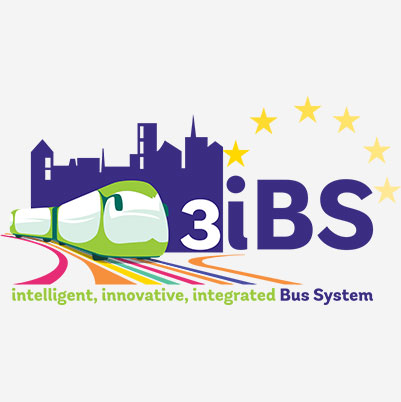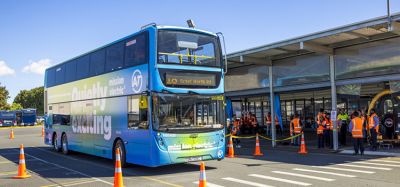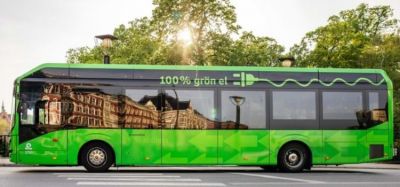The intelligent, innovative, integrated Bus Systems project (3iBS)
- Like
- Digg
- Del
- Tumblr
- VKontakte
- Buffer
- Love This
- Odnoklassniki
- Meneame
- Blogger
- Amazon
- Yahoo Mail
- Gmail
- AOL
- Newsvine
- HackerNews
- Evernote
- MySpace
- Mail.ru
- Viadeo
- Line
- Comments
- Yummly
- SMS
- Viber
- Telegram
- Subscribe
- Skype
- Facebook Messenger
- Kakao
- LiveJournal
- Yammer
- Edgar
- Fintel
- Mix
- Instapaper
- Copy Link
Posted: 22 December 2014 | Michele Tozzi and Pauline Bruge, UITP European Project Manager
The intelligent, innovative, integrated Bus Systems project (3iBS1) has been founded on the consideration that buses still remain the most universal solution for sustainable urban development, effectively taking into account its economic, environmental and social perspectives…


The intelligent, innovative, integrated Bus Systems project (3iBS1) has been founded on the consideration that buses still remain the most universal solution for sustainable urban development, effectively taking into account its economic, environmental and social perspectives. Following the outcomes of previous research programmes on bus systems (in particular the European Bus System of the Future project – EBSF), nine partners together with approximately 30 associated members and under the coordination of the UITP, are actively working to strengthen the competitiveness of bus transportation in the urban environment, by promoting efficient answers to citizens’ mobility needs and bus stakeholders’ demands. UITP European Project Managers Michele Tozzi and Pauline Bruge provide more information.
Rationale
Towns and cities across Europe are facing growing mobility challenges due to a constant increase of passengers’ flows in/out and within densely populated areas. Urban sprawl and new mobility habits have resulted in chronic congestion throughout European cities, with the consequences that this entails in terms of air pollution, accident rates and accessibility problems.
As a matter of fact, bus systems are the primary form of public transport both in Europe, where around 56%2 of all passengers’ journeys made by local public transport are undertaken via urban and suburban buses, and worldwide, where the bus market share is estimated at 80%. Buses are more environmentally-friendly than cars (in terms of energy efficiency, emissions and space occupancy), are a public transport mode tailored to the needs of end-customers in terms of network coverage and capacity and they do not require heavy infrastructure to be put in service. However, the bus is still sometimes perceived as a less attractive option among public transport modes, because of its low performance mainly in terms of regularity, speed, comfort and design.
Focusing on the ‘system approach’3, developed in the frame of the EBSF project, 3iBS identified seven key areas with high potential in generally perfecting bus infrastructures and operations, namely:
- Ensuring accessibility and safety measures to bus infrastructures and vehicles
- Adapting accessibility and optimising operations to special events
- Identifying new energy strategies while reinforcing the existing and successful policies
- Adjusting internal and external modularity to the operational scenario
- Inter-modality with private and public transport modes
- Restoring the service level and developing innovative solutions to prioritise the bus system
- Standardising the IT platform for bus systems previously developed by the EBSF.
All-in-all, the exploitation of results and further development of the selected research areas will help to make bus systems more attractive for passengers and more efficient and economical to operate, reinforcing the position of the European bus industry.
Validate innovative solutions through the analysis of study cases
For each of the aforementioned topics, a set of outstanding study cases obtained from the experience of public transport operators has been selected. More than 30 operational or infrastructural solutions tested in France, Germany, Italy, the Netherlands, Spain, United Kingdom, Turkey and South Africa have been analysed in order to assess how the concept of the bus system, as defined in the EBSF and other similar projects, has been successfully implemented in the real experience of urban mobility.
Guidelines for the implementation of such good practices across European cities have been produced to support PT stakeholders interested to implement these solutions. Additionally, recommendations for research, implementation and regulation have also been produced as an input for the Roadmap for European Advanced Bus Systems research.
European bus system strategies: state-of-the-art and future tendencies
The 3iBS project works not only through case studies. In order to identify the actual implementation status of bus system strategies in European cities, a consultation was launched in the form of a questionnaire addressed to public transport operators, public transport authorities and municipalities. Collected data produces up-to-date quantitative information on both the state-of-the-art of the bus fleet in operation in Europe and future tendencies by focusing on four main areas of interest: fleet composition; propulsion systems; Intelligent Transport Systems; and future policies impacting bus systems.
The analysis of a fleet of around 70,000 buses and trolleybuses serving a population of over 100 million inhabitants in 24 countries provided a significant snapshot of 63 bus fleets operated in European cities, metropolitan areas and regions and highlights the importance of bus systems in local mobility policies. The complete results of the survey have been published within the project deliverables, whereas an overview of the main outcomes is presented hereafter.
If we consider a bus fleet breakdown based on vehicle length, the resulting average composition is presented in Figure 1. Needless to say, the majority of the operated buses belong to the standard class. The residual fleet is mainly shared between articulated buses and double-deckers as well as midi buses (9-11m). The snapshot is completed by trolleybuses, mini buses (less than 9m) and 3-axle 15m buses (other in the bar chart).
To highlight the main future tendencies in terms of bus fleet composition, it is worth noticing that 75% of the respondents intend to change the current fleet ratio in terms of vehicle size: the majority wants to strengthen vehicles categories already in operation in their fleet, however, one out of five participants of the survey wants to include new vehicle categories. As the analysis shows, 69% of the respondents want to move towards more articulated buses and 40% of them towards midi-buses. This tendency seems to suggest the need, on one hand, to respond to the growing demand of commuters travelling from the outskirts of the city to the city centres and, on the other hand, to buy well-tailored buses to operate services in the city centres (more flexible, occupying less space and more environmentally-friendly).
Focusing on the propulsion system (see Figure 2), the bus fleets surveyed confirm that the majority of the vehicles in operation in urban and suburban areas are diesel fuelled (79%), followed by biodiesel (9.9%), CNG – Compressed Natural Gas (7.0%), electric vehicles (1.2%) and biogas (0.6%).
Also in this case, the comparison between the state-of-the-art and the future plans stated by the stakeholders allows to identify significant trends (see Figure 3): more than 40% of the respondents want to introduce in their fleet more electric buses, namely hybrids (43%), fully electric with batteries (28%), plug in hybrids (21%) and fully electric trolleys (9%). This value seems to be coherent with the tendencies aforementioned in terms of vehicle categories. Moreover, it is notable that one out of three respondents wants to stay with diesel – without implementing major changes in terms of present fleet composition – while 28% want to change in favour of more CNG, 18% towards more biodiesel and 13% towards more biogas.
In line with the main objectives of the project, the survey also aims to estimate the role of bus systems in the European mobility policies and the will of public and private stakeholders to improve the efficiency of the bus systems currently in operation. The majority of the surveyed stakeholders (70%) are working on specific strategies to increase the market share of public transport and this awareness tends to be higher in larger cities, with 79% of the respondents representing cities with more than 2.5 million inhabitants. The bus seems to play a key role in such strategies: for 68% of the respondents bus systems are participating to a great extent in future policies to increase the attractiveness of public transport, which will be financed mainly through mixed public funding at municipal, national and European level, ticket revenues (also considering to increase the ticket price) and extra tax subsidies.
Towards a ‘Roadmap for European Advanced Bus Systems’
The final goal of the project is to develop a ‘Roadmap for European Advanced Bus Systems’ research that will support national and European institutions in identifying the main priorities for research on bus systems. The first issue of the Roadmap was published in 2011 as part of the EBSF project in the frame of ERTRAC (European Road Transport Research Advisory Council) and was supported by more than 100 key bus stakeholders. On those bases, the Roadmap for Advanced Bus Systems is going to be updated by the recommendations for research produced within 3iBS as well as the review of results of finished and on-going projects and initiatives on bus systems or specific bus system elements (e.g. ZeEUS, CAPITAL, ERTRAC, NODES, ITxPT, OPTICITES).
All 3iBS partners are working actively to give a new identity to the urban and suburban bus systems and make the bus a competitive mode of transport for both passengers and operators. The new generation of bus systems which is being promoted through the Roadmap will eventually help European cities to answer the equation ‘more mobility = more sustainability’.
Acknowledgements
The authors wish to thank all 3iBS members who actively contributed to the results reported in this article.
References
- 3ibs.eu
- UITP, Statistic Brief – Local Public Transport Trends in the European Union, June 2014
- The EBSF project didn’t look at the vehicle in isolation but as one of the elements integrated in the whole bus system together with infrastructural requirements and operation concepts. Such logic, called ‘the system approach’ reflects also the involvement in the project of all the main bus system stakeholders: the organising authorities and municipalities, the operators and the bus manufacturing industries.
Biography
Michele Tozzi is a Civil Engineer with a Ph.D. in Transportation Engineering of ‘Sapienza’ University of Rome. He joined the UITP in January 2013 as European Project Manager. His professional experience includes consulting activities at national and European level and the involvement in several EU-funded projects mainly in the field of transit systems and urban mobility.
Pauline Bruge is European Projects Manager at the UITP. She graduated from the Institut d’Etudes Politiques of Lille and Kent University (UK) with a Bachelor of Politics and International Relations and a Master of International Law and Political Science. Pauline joined the UITP in 2011 to work on the EBSF project. She is now working on various projects related to urban bus (3iBS and ZeEUS) and more cross-cutting issues for public transport (information technology, CIVITAS initiative, international cooperation).
Related topics
Business Models, Sustainable Urban Transport
Issue
Issue 6 2014
Related modes
Bus & Coach
Related organisations
International Association for Public Transport (UITP)
Related people
Pauline Bruge








